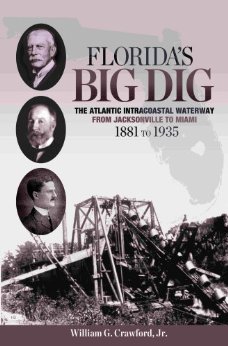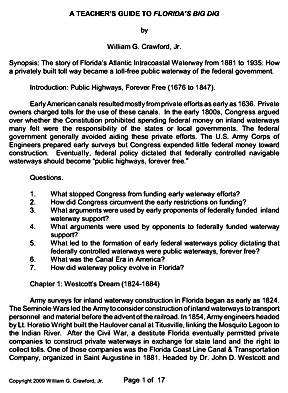FHS Classroom Resources
These modules are designed for teachers and students to be able to access and interpret primary sources found at the Library of Florida History. The Florida Historical Society has, for over a century, collected and preserved original documents and records relating to the history of Florida. Yet, the use of original documents in the classroom is often hindered by access to vetted archival repositories. This is an ongoing effort by the Florida Historical Society to create thematic modules which teachers and students are encouraged to download and use in the classroom. These modules are designed for students in grades 4-12, but can be adapted for use in both lower and upper levels. Many of these documents can be utilized outside of the social studies curriculum to connect history with other disciplines.
The first three modules (Slavery in Florida, The Civil War Soldier, and Reconstruction in Florida) in this classroom series were created with financial assistance through a grant from the Florida Council of Social Studies Endowment Board. Special thanks to Heather Pierce for creating much of the content for these first three modules. Additional resources include books published by FHS Press with a guide.
*All documents are housed at the Florida Historical Society Library of Florida History unless otherwise noted.
Click on the below outline links for resources:
Slavery in Florida
As early as the 16th century when Europeans began coming to Florida’s shores, slaves have been an important component of the cultural and social dynamic of the state. By the time Florida became a United States territory in 1821, slavery had become an integral part of the Middle Florida plantation economy. The system of African slavery in Florida was more closely related to other southern states of the time leading up to the American Civil War however. Florida has become part of the great cotton belt which produced a large quantity of the country’s cotton from this slave labor system. This module will focus on the decades leading up to 1861 when slavery had reached its pinnacle in Florida. Students will read and discuss primary documents relating to the institution of slavery in Florida. Each document is accompanied by suggested review questions that will help students engage with the documents in a meaningful way.
Downloads:
Florida's Big Dig
This book is the story of people of vision and courage, of a small group of prominent Saint Augustine investors who conceived of the Florida waterway and began the first dredging work; of an obscure group of New England capitalists who provided significant financing and obtained a million acres of undeveloped Florida public land in pursuing what was, at best, a speculative enterprise; of innumerable citizen groups like the Florida east coast chamber associations and the larger Atlantic Deeper Waterways Association that demanded at the turn of the last century what they believed was the peoples right-a public waterway, free of the burden of tolls; and finally, of the US Army Corps of Engineers, who conducted all of the Florida waterway's early surveys and assumed the project's control in 1929 to convert what was once a private toll way into Florida's modern-day, toll-free Atlantic Intracoastal Waterway.
A TEACHER’S GUIDE TO FLORIDA’S BIG DIG
by William G. Crawford, Jr.
Synopsis: The story of Florida’s Atlantic Intracoastal Waterway from 1881 to 1935: How a privately built toll way became a toll-free public waterway of the federal government.
Click on image or file link near bottom of page to download PDF of teachers guide. The Teacher's Guide is free to use.
The book in both hardback and paperback is availble from the book store of the Florida Historical Society.
PDFfile:
The Civil War Soldier
The Civil War was the bloodiest conflict on American soil. Florida was deeply involved in every aspect of the conflict. Thousands of Floridians fought for both the Union and Confederate Armies and Navies. The primary catalyst for war was the election of President Abraham Lincoln in 1860. Many Floridians feared President Lincoln would abolish slavery, thus upsetting the social and economic system of the state. At the center of this large-scale conflict was the Civil War soldier. Of the thousands of Floridians that went off to war, many never returned. This module focuses on the day to day experiences of soldiers fighting in and outside of Florida’s boundaries, as well as the toll paid by family members these soldiers left behind. Students will be able to build on their previous understanding of the Civil War with supplemental primary materials from those who experienced the conflict first hand.
Downloads:
Forcing Change
It is June 1963 and fifteen-year-old Margaret Jefferson is being arrested at a sit-in at a lunch counter in St. Augustine. The Civil Rights Movement has found its way into her hometown, and Maggie feels a deep need to be a part of it. She believes in the ideals of the movement and the ultimate goal of equality. She also finds the nonviolence that the protestors are committed to very comforting.
However, as the summer and fall of 1963 unfold in St. Augustine, their nonviolent protests are met with rising resistance, aggression, and intimidation from local government officials as well as the Ku Klux Klan. Cattle prods used on protestors, firebombs thrown into the homes of families trying to integrate the schools. teenagers held in jail indefinitely. No one is safe, it seems.
This story, told through Maggie's innocent and hopeful eyes, will help a new generation of young people to understand the strength and sacrifices of those who worked so hard for civil rights in this country. It will also help to shine the spotlight on the role that St. Augustine, and Florida, had in the movement.
Judy Lindquist is the author of the acclaimed historical novel Saving Home, used in classrooms throughout the state to engage students in the study of Spanish colonial St. Augustine. She teaches fourth grade students in Orange County, and aspiring teachers at the University of Central Florida.
PDFfile:
Reconstruction in Florida
The Civil War official ended in April of 1865, yet the county had been torn apart both literally and figuratively. Much of the infrastructure and economy in the southern states were devastated. Tens of thousands of wounded soldiers struggled to return home and return to civilian life but the problem of readmitting the Confederate state back into the Union was complicated and fraught with difficulty. For years after the last shots were fired, many former Confederate states including Florida were under military rule. Politicians from the north occupied public posts which angered many former Confederates. The documents contained in this module examine some of the challengers brought about by Reconstruction. Students will examine firsthand accounts of Reconstruction efforts in Florida from a variety of different angles. Challenge students to understand all sides of this complex part of American history.
Downloads:
Saving Home
“Saving Home is an historical novel set during the English siege of St. Augustine in 1702. The story is told through the eyes of nine-year-old Luissa de Cueva and her friends, ten-year-old Diego de las Alas, and a Timucuan Indian girl named Junco. Based on meticulous research, Saving Home engages readers of all ages with descriptions of Spanish and Native American families seeking refuge for more than six weeks within the walls of the Castillo de San Marcos as St. Augustine goes up in flames and a battle rages around them. This exciting historical novel has messages about life, family, and what is important that will resonate with both the young and the young hearted.”
-Author
Below is a Teachers Guide in pdf format that can be downloaded or viewedon this page






